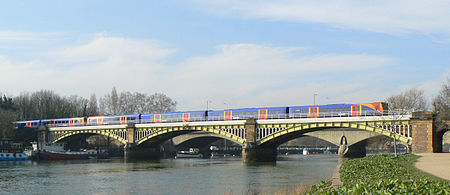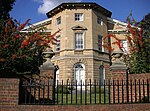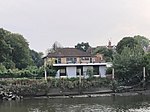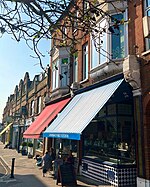Richmond Railway Bridge

Richmond Railway Bridge in Richmond, south-west London, crosses the River Thames immediately upstream of Twickenham Bridge. It carries National Rail services operated by South Western Railway (SWR) on the Waterloo to Reading Line, and lies between Richmond and St. Margarets stations. The bridge was amongst the first railway crossings of the Thames.The first Richmond Railway Bridge was built by the contractor Thomas Brassey and designed by the civil engineers Joseph Locke and J. E. Errington on behalf of the London and South Western Railway (L&SWR). Opened during 1848, it was originally known as the Richmond Windsor and Staines Railway Bridge. Due to concerns over the bridge's use of cast iron in its construction, it was rebuilt during the 1900s, the principal change being the substitution of iron elements for steel counterparts. This second bridge, which heavily reused elements of the original, was designed by the L&SWR's then-chief engineer, J. W. Jacomb-Hood, and constructed by the Horseley Bridge Company between 1906 and 1908. The second bridge is visually similar to the earlier structure, retaining much of its aesthetics and original features despite subsequent refurbishment and maintenance programmes, including the replacement of its decking and girders during the 1980s. Since 2008, both the bridge itself and its brick approach viaduct have been Grade II listed structures, protecting them from unsympathetic alterations.
Excerpt from the Wikipedia article Richmond Railway Bridge (License: CC BY-SA 3.0, Authors, Images).Richmond Railway Bridge
Cholmondeley Walk, London St Margarets (London Borough of Richmond upon Thames)
Geographical coordinates (GPS) Address External links Nearby Places Show on map
Geographical coordinates (GPS)
| Latitude | Longitude |
|---|---|
| N 51.46 ° | E -0.31361111111111 ° |
Address
Cholmondeley Walk
TW9 1NS London, St Margarets (London Borough of Richmond upon Thames)
England, United Kingdom
Open on Google Maps









